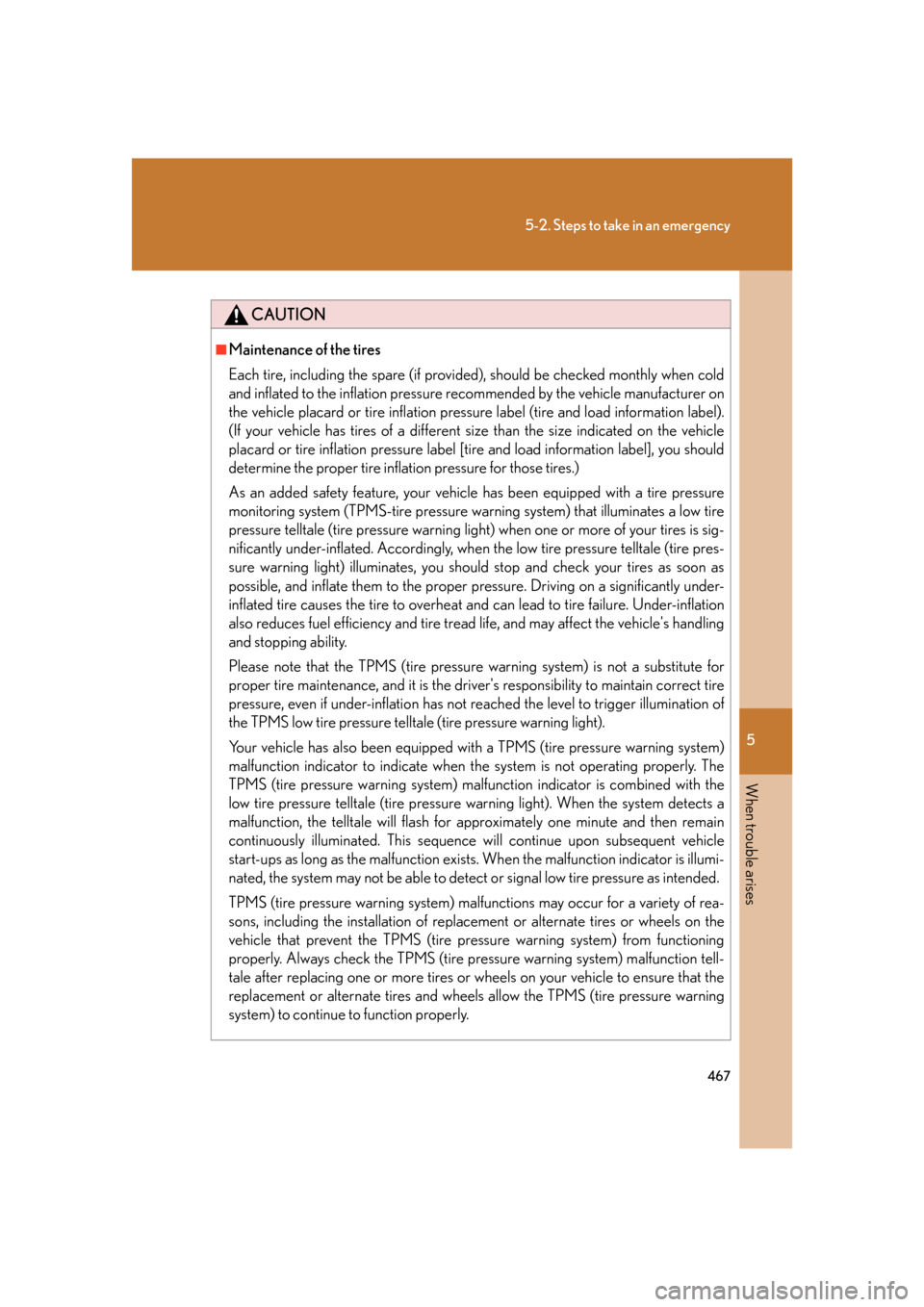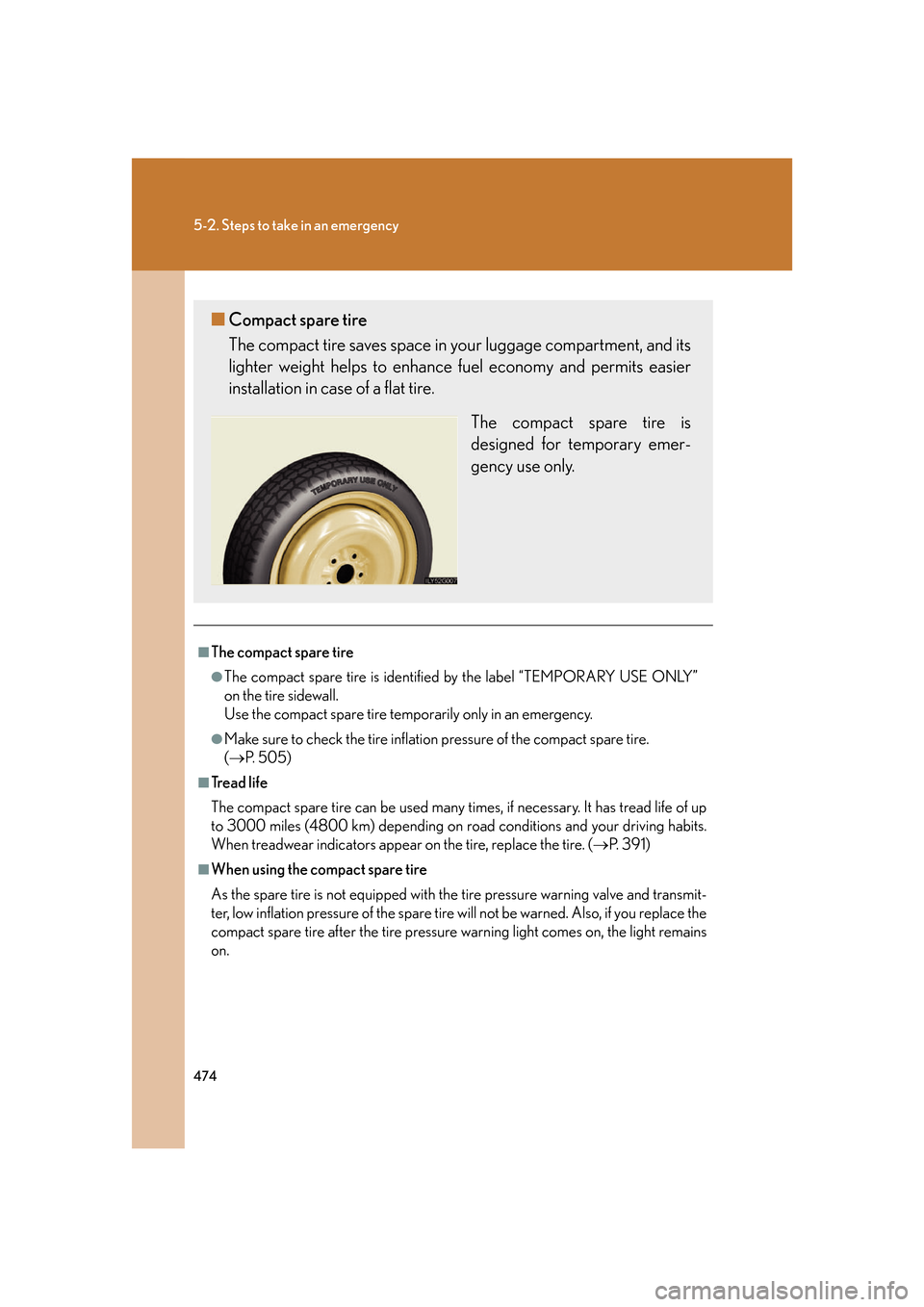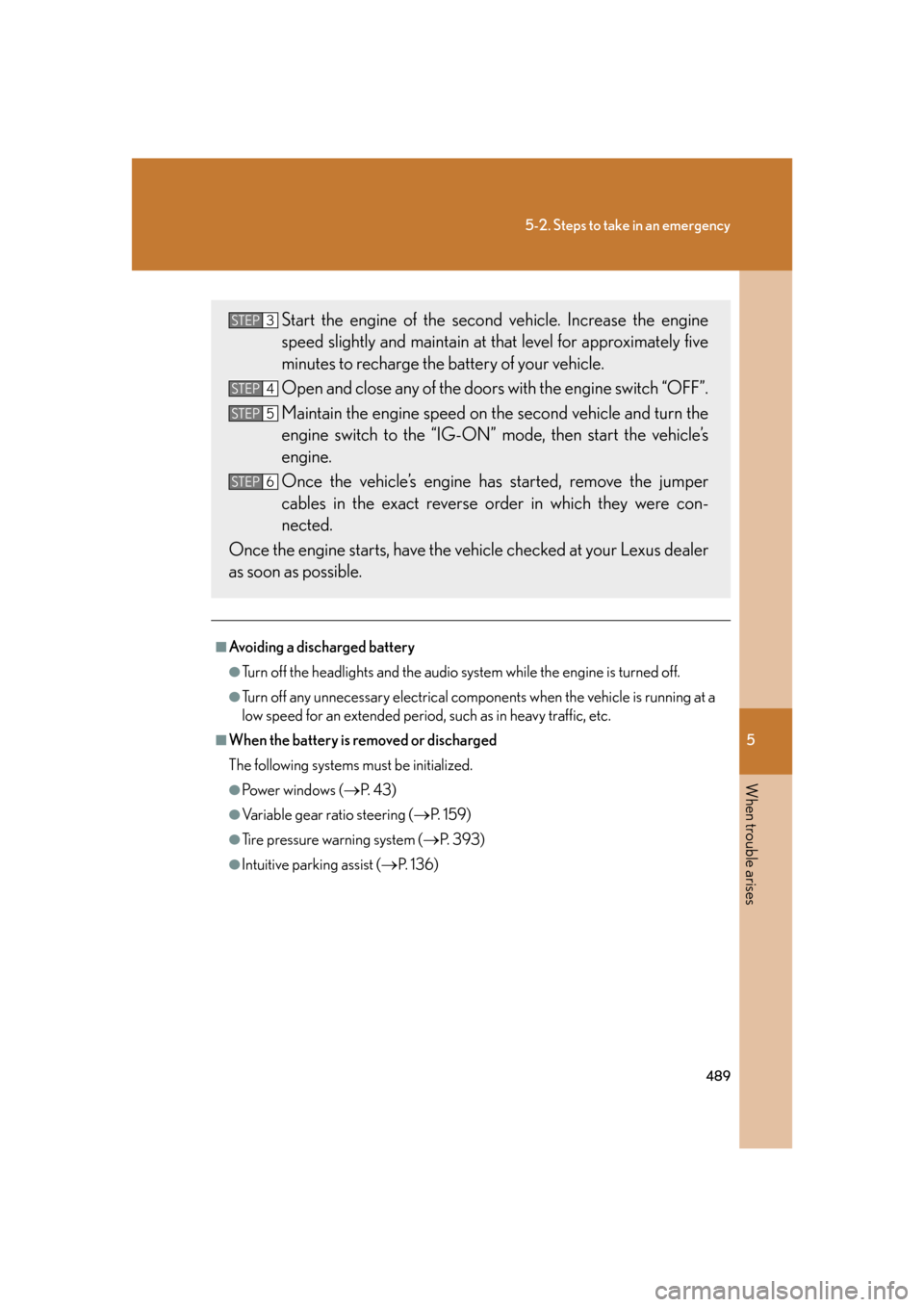tire pressure Lexus GS350 2007 Using the front audio system / LEXUS 2007 GS430/350 (OM30A04U) Owner's Guide
[x] Cancel search | Manufacturer: LEXUS, Model Year: 2007, Model line: GS350, Model: Lexus GS350 2007Pages: 562, PDF Size: 17.95 MB
Page 484 of 562

464
5-2. Steps to take in an emergency
Wa r n i n g m e s s a g eDetailsCorrection procedure
(U.S.A. only)
The engine oil is sched-
uled to be changed.
Check the engine oil, and
change if necessary.
Comes on approximately
4500 miles (7200 km)
after the engine oil is
changed. (The indicator
will not work properly
unless the oil mainte-
nance data has been
reset).
(U.S.A. only)
The engine oil should be
changed.
Check and change the
engine oil.
Comes on approximately
5000 miles (8000 km)
after the engine oil is
changed (and the oil
maintenance data has
been reset).
Low tire inflation pres-
sure.Check the tire inflation
pressure, and adjust to the
appropriate level.
Page 487 of 562

5
When trouble arises
467
5-2. Steps to take in an emergency
CAUTION
■Maintenance of the tires
Each tire, including the spare (if provided), should be checked monthly when cold
and inflated to the inflation pressure re commended by the vehicle manufacturer on
the vehicle placard or tire inflation pressure label (tire and load information label).
(If your vehicle has tires of a different size than the size indicated on the vehicle
placard or tire inflation pressure label [tire and load information label], you should
determine the proper tire inflation pressure for those tires.)
As an added safety feature, your vehicle has been equipped with a tire pressure
monitoring system (TPMS-tire pressure warning system) that illuminates a low tire
pressure telltale (tire pressure warning light) when one or more of your tires is sig-
nificantly under-inflated. Accordingly, when the low tire pressure telltale (tire pres-
sure warning light) illuminates, you should stop and check your tires as soon as
possible, and inflate them to the proper pressure. Driving on a significantly under-
inflated tire causes the tire to overheat an d can lead to tire failure. Under-inflation
also reduces fuel efficiency and tire tread life, and may affect the vehicle's handling
and stopping ability.
Please note that the TPMS (tire pressure warning system) is not a substitute for
proper tire maintenance, and it is the driver's responsibility to maintain correct tire
pressure, even if under-inflation has not reached the level to trigger illumination of
the TPMS low tire pressure telltale (tire pressure warning light).
Your vehicle has also been equipped with a TPMS (tire pressure warning system)
malfunction indicator to indicate when th e system is not operating properly. The
TPMS (tire pressure warning system) malf unction indicator is combined with the
low tire pressure telltale (tire pressure warning light). When the system detects a
malfunction, the telltale will flash for approximately one minute and then remain
continuously illuminated. This sequence will continue upon subsequent vehicle
start-ups as long as the malfunction exists . When the malfunction indicator is illumi-
nated, the system may not be able to detect or signal low tire pressure as intended.
TPMS (tire pressure warning system) malfunctions may occur for a variety of rea-
sons, including the installation of replacem ent or alternate tires or wheels on the
vehicle that prevent the TPMS (tire pressure warning system) from functioning
properly. Always check the TPMS (tire pressure warning system) malfunction tell-
tale after replacing one or more tires or wheels on your vehicle to ensure that the
replacement or alternate tires and wheels allow the TPMS (tire pressure warning
system) to continue to function properly.
Page 492 of 562

472
5-2. Steps to take in an emergency
If you have a flat tire (Vehicles with run-flat tires)
■In some condition (such as at high temperatures)
You can not continue driving for up to
100 miles (160 km).
■If you cannot distinguish between the standard tires and run-flat tires
Consult your Lexus dealer.
■For the detailed information on run-flat tires
See the tire warranty book.
NOTICE
■When replacing the tires
●Have the tires replaced by the nearest Lexus dealer or authorized tire dealer. The
tire pressure warning valves and transmitters will be affected by the installation or
removal of tires.
●Replace the grommets for the tire pressure warning valves and transmitters as
well.
■To avoid damaging the tire pressu re warning valves and transmitters
Do not use liquid sealants on flat tires.
Take your vehicle to the nearest Lexus dealer or authorized tire dealer as
soon as possible.
■ Run-flat tires (A “RFT” or “DSST” mark is molded on the sidewall)
You can continue driving a vehi-
cle with run-flat tires even if any
tir
e goes flat.
It is able to run for a maximum of
100 miles (160 km) at a speed
below 55 mph (90 km/h) after
the tire pressure warning light
comes on. ( P. 4 5 2 )
Page 494 of 562

474
5-2. Steps to take in an emergency
■The compact spare tire
●The compact spare tire is identified by the label “TEMPORARY USE ONLY”
on the tire sidewall.
Use the compact spare tire temporarily only in an emergency.
●Make sure to check the tire inflatio n pressure of the compact spare tire.
( P. 505)
■Tr e a d l i f e
The compact spare tire can be used many times, if necessary. It has tread life of up
to 3000 miles (4
800 km) depending on road conditions and your driving habits.
When treadwear indicato rs appear on the tire, replace the tire. ( P. 3 9 1 )
■When using the compact spare tire
As the spare tire is not equipped with th e
tire pressure warning valve and transmit-
ter, low inflation pressure of the spare tire will not be warned. Also, if you replace the
comp
act spare tire after the tire pressure warning light comes on, the light remains
on.
■ Compact spare tire
The compact tire saves space in your luggage compartment, and its
lighter weight helps to enhance fuel economy and permits easier
installation in case of a flat tire.
The compact spare tire is
designed for tempor
ary emer-
gency use only.
Page 499 of 562

5
When trouble arises
479
5-2. Steps to take in an emergency
Firmly tighten each nut two or
three times in the order shown in
the illustration.
Tightening torque:
76 ft•lbf (103 N•m, 10.5 kgf•m)
Stow the flat tire, tire jack and all tools.
STEP4
■If you have a flat rear tire on a road covered with snow or ice
Install the compact spare tire on the front of the v
ehicle. Perform the following steps
and fit tire chains to the rear tires.
Replace a front tire with the compact spare tire.
Replace the flat rear tire with the tire removed from the front of the vehi -
cle.
Fit tire chains to the rear tires.
■After completing the tire change
The tire pressure warning system must be reset. ( P.
3 9 2 )
STEP5
STEP1
STEP2
STEP3
Page 502 of 562

482
5-2. Steps to take in an emergency
NOTICE
■Do not drive the vehicle with a flat tire
Do not continue driving with a flat tire.
Driving even a short distance with a flat tire can damage the tire and the wheel
beyond repair.
■Be careful when driving over bumps with the compact spare tire installed on the
vehicle
The vehicle becomes lower when driving with the compact spare tire compared to
when driving with standard tires. Be careful when driving over uneven road sur-
faces.
■Driving with tire chains and the compact spare tire
Do not fit tire chains to the compact spare tire.
Tire chains may damage the vehicle body and adversely affect driving performance.
■When replacing the tires
●When removing or fitting the wheels, tires or the tire pressure warning valve and
transmitter, contact your Lexus dealer as the tire pressure warning valve and
transmitter may be damaged if not handled correctly.
●Replace the grommets for the tire pressure warning valves and transmitters as
well.
■To avoid damaging the tire pressure warning valves and transmitters
Do not use liquid sealants on flat tires.
Page 509 of 562

5
When trouble arises
489
5-2. Steps to take in an emergency
■Avoiding a discharged battery
●Turn off the headlights and the audio system while the engine is turned off.
●Turn off any unnecessary electrical compon ents when the vehicle is running at a
low speed for an extended period, such as in heavy traffic, etc.
■When the battery is removed or discharged
The following systems must be initialized.
●Po w e r w i n d o w s (P. 4 3 )
●Variable gear ratio steering (P. 1 5 9 )
●Tire pressure warning system (P. 3 9 3 )
●Intuitive parking assist (P. 1 3 6)
Start the engine of the second vehicle. Increase the engine
speed slightly and maintain at that level for approximately five
minutes to recharge the battery of your vehicle.
Open and close any of the doors with the engine s
witch “OFF”.
Maintain the engine speed on th e second v
ehicle and turn the
engine switch to the “IG-ON” mode, then start the vehicle’s
engine.
Once the vehicle’s engine ha s star
ted, remove the jumper
cables in the exact reverse ord er in which they w
ere con-
nected.
Once the engine starts, have the ve hicle check
ed at your Lexus dealer
as soon as possible.
STEP3
STEP4
STEP5
STEP6
Page 525 of 562

505
6-1. Specifications
6
Vehicle specifications
Steering
Tires and wheels
Type A
Free playLess than 1.2 in. (30 mm)
Ti r e s i z e245/40R18 93Y, P245/40R18 93V, T155/
70D17 110M (spare)
Front and rear tire inflation
pressure
(Recommended cold tire inflation
pressure)
Driving under normal conditions33 psi (230 kPa, 2.3 kgf/cm2 or bar)
Driving at high speeds above 100 mph
(160km/h) (in countries where such speeds
are permitted by law) Add 9 psi (60 kPa, 0.6 kgf/cm
2 or bar) to
the front tires and rear tires. Never exceed
the maximum cold tire inflation pressure
indicated on the tire sidewall.
Spare tire inflation pressure
(Recommended cold tire inflation
pressure)
60 psi (420 kPa, 4.2 kgf/cm2 or bar)
Wheel size18 8 JJ, 17 4T (spare)
Wheel nut torque76 ft•lbf (103 N•m, 10.5 kgf•m)
Page 526 of 562

506
6-1. Specifications
Ty p e B
Ti r e s i z e225/50R17 94W, P225/50R17 93V, T155/
70D17 110M (spare)
Front and rear tire inflation
pressure
(Recommended cold tire inflation
pressure)
Driving under normal conditions 33 psi (230 kPa, 2.3 kgf/cm2 or bar)
Driving at high speeds above 100 mph
(160km/h) (in countries where such speeds
are permitted by law) Add 7 psi (50 kPa, 0.5 kgf/cm
2 or bar) to
the front tires and rear tires. Never exceed
the maximum cold tire inflation pressure
indicated on the tire sidewall.
Spare tire inflation pressure
(Recommended cold tire inflation
pressure)
60 psi (420 kPa, 4.2 kgf/cm2 or bar,)
Wheel size17 7 1 /2 JJ, 17 4T (spare)
Wheel nut torque76 ft•lbf (103 N•m, 10.5 kgf•m)
Page 532 of 562

512
6-1. Specifications
Typical DOT and tire identification number (TIN)
DOT symbol*
Tire Identification Number (TIN)
Tire manufacturer’s identifica-
tion mark
Tire size code
Manufacturer’s optional tire
type code (3 or 4 letters)
Manufacturing week
Manufacturing year
*: The DOT symbol certifies that
the tire conforms to applicable
Federal Motor Vehicle Safety
Standards.
Radial tires or bias-ply tires
A radial tire has RADIAL on the sidewall. A tire not marked RADIAL is a
bias-ply tire.
TUBELESS or TUBE TYPE
A tubeless tire does not have a tube and air is directly filled in the tire. A tube
type tire has a tube inside the tire and the tube maintains the air pressure.
Load limit at maximum cold tire inflation pressure ( P. 5 1 7 )
Maximum cold tire inflation pressure ( P. 5 1 7 )
This means the pressure to which a tire may be inflated.
Uniform tire quality grading
For details, see “Uniform Tire Quality Grading” that follows.
Summer tire or all season tire (P. 395)
An all season tire has “M+S” on the si dewall. A tire not marked “M+S” is a
summer tire.
“TEMPORARY USE ONLY” ( P. 4 74 )
A compact spare tire is identified by the phrase “TEMPORARY USE ONLY”
molded into its sidewall. This tire is designed for temporary emergency use only.